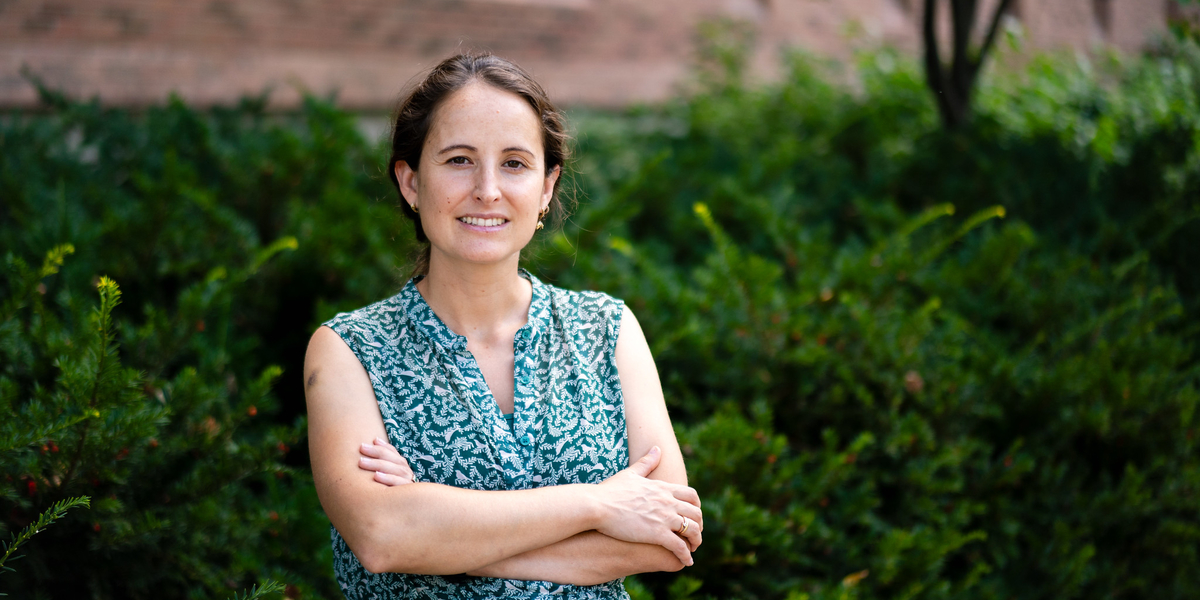
Beatriz Baselga Cervera did well in school and thrived in biology as a teenager. She was smart, ambitious and disciplined, so a future in medicine seemed a rational choice. Her sister wasn’t so sure. “My sister said, ‘Why? You’re way more happy around cows than people.’ And it was true,” laughs Baselga Cervera, who says she was frequently caught smuggling mice, pigeons, snakes and chickens into her grandma’s house in the Spanish countryside. “So I went to veterinary school and I loved it.”
The school part she loved. The animals she loved even more – even now, one of the great loves of her life is her dog, Nia, a lab-pit mix with a huge personality. But it didn’t take long for the daily practice of veterinary medicine to wear on her. She felt she spent more time navigating the business side of things than actually caring for her beloved animal clientele. “It was a lot of little things that added up,” says Baselga Cervera, who’s now one of the newest faculty members in the Department of Ecology, Evolution, and Behavior (EEB). “I realized I didn’t want to just do a job. I wanted to be happy at my job, too.”
So she decided to go back to school for research and pursued a master’s degree in research in veterinary sciences at the veterinary school where she earned her first degree. “In Spain, lot of public-health research goes through the veterinary institution,” says Baselga Cervera. For example, food-quality research goes through veterinary doctors because they work in slaughterhouses. Someone decided that water quality would also go through the veterinary school, too – and her veterinary mentors thought she might be a good fit for the program.
Baselga Cervera’s first publication in aquatic biology investigated the microbial life of uranium-polluted waters. She fell in love with understanding the evolutionary contexts of strange or obscure life-forms that can survive in extreme conditions. Next stop? Ph.D. A brief six-month fellowship in EEB Professor Mike Travisano’s lab while Baselga Cervera was a Ph.D. student at Universidad Complutense de Madrid was all Baselga Cervera needed to grow roots in Minnesota. She decided to pursue a postdoctoral position in Travisano’s lab when her graduate fellowship was over.
The Travisano lab seeks to understand the causes of biological complexity by studying the ecological and evolutionary feedback loops of small, closed systems. He seeks to understand how an environment can shape how a species evolves over time, but then also how that same species can affect its environment. Working with Travisano gave Baselga Cervera the context and confidence needed to move beyond his yeast system into working with more complex bacterial systems.
“I wanted to work with his system because it’s really well studied,” she says. “I was able to learn the molecular tools from that system and apply it to more complicated systems.”
After wrapping up her graduate studies in Spain she applied to a postdoctoral position in the Travisano lab. Fast forward nearly five years, and Baselga Cervera recently joined the faculty as an assistant professor in EEB. In the time between her Ph.D. and her new position as faculty member and professor, Baselga Cervera has written several papers, endured a global pandemic, fallen in love, and poured a lot of energy into translating research into Spanish using a platform called at estornuda.me that reached nearly a million subscribers. Her interests intersect in the fields of ecology, microbiology, evolution and limnology (the study of lakes). But her work also applies to the origins of life, astrobiology (understanding the possibilities of life that could exist beyond our planet), science communication and philosophy.
“I want experiments to provide a bit more room for answers,” says Baselga Cervera. “I don’t start an experiment expecting a particular outcome or answer. Generally I start with a question and let the biology do the talking. I want to know, what would the system tell me about this question?”
A primary goal of her research is to understand the evolutionary context of cyanobacteria. These tiny microbes are often the culprits of “algae blooms” but are actually bacteria that photosynthesize and produce compounds that, in large quantities, can be toxic to humans and other organisms. They’re relatively well studied, but it’s not understood why cyanobacteria adapted to produce these compounds in the first place. Her cyanobacteria research could help inform environmental policy and water management – especially considering that several lakes across Minnesota close down almost every year due to these toxins – but they also inform a wide range of topics like evolutionary theory, the origins of life, limnology (the study of lakes), ecology, microbiology and astrobiology (the study of life beyond our planet).
In general, Baselga Cervera loves to study the strange, the understudied, and the mysterious. She also likes any opportunity to get outside. So when she found out she could collect microbes called Magnetotactic bacteria from a stream at Itasca Biological Research Station and Laboratories, she was hooked. Magnetotactic bacteria quite literally contain magnetic particles sensitive to the Earth’s magnetic fields. This trait is easily observed – and therefore could serve as a great tool for investigating questions about ecological and evolutionary feedback loops on a small scale.
She feels much more settled in her career than she did as a veterinarian in Spain. The intellectual intrigue, the ability to spend time outdoors and flexibility to take a variety of directions in her research… all of these keep her grounded and excited about her new position. But most significantly, she loves the people here. “Everybody needs a community,” she says. “As scientists, we’re not smarter than anybody else, we're not better than anybody else, we're just in a different bucket of knowledge. It feels great to be a part of a community you identify with.” – Adara Taylor